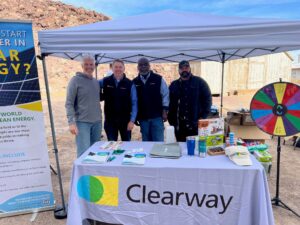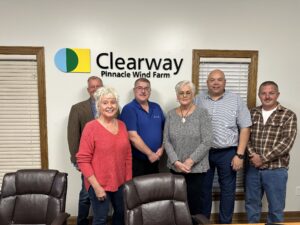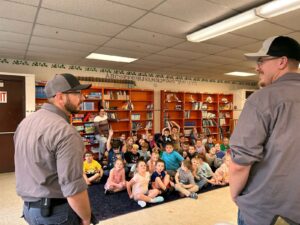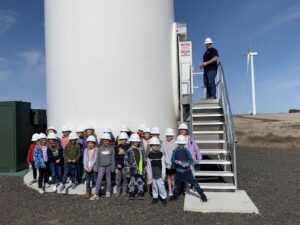Putting neighbors first: Why the clean energy industry must invest in community engagement

The growth of renewable energy across the country is driving the development of solar and wind farms in nearly every state. While that growth means more reliable and affordable power on the grid, it also means that more communities are coming into contact with energy developers and projects.
Community engagement must be present at every stage of a project: from development in the years leading up to construction, during the build, and through decades of operations.
This month, we interviewed three leaders from Clearway’s team who are creating the internal processes, operating principles, and programs for community engagement. Julia Zuckerman is head of external affairs in the west, Callie Dayton is a manager in the east, and Amelia Houser supports all onsite operations across 26 states.
Why is community engagement so important right now? Why does it come up so much in the context of large-scale energy projects?
Julia – The increasing pace of project development across the country, particularly with the Inflation Reduction Act, means that more people are encountering renewable energy projects in their local communities. As the renewable energy industry matures, everyone will naturally have higher expectations.
Clearway, and the broader renewable industry, have established a track record of reliability and longevity, and now there is a growing expectation for us to be responsible, productive, and active neighbors. Community engagement means working with and not just in site communities, and it is a natural progression as the industry matures.
Callie – Growing up in a small community, when there was talk of a new company or industry coming to town, it was a big deal. After having some bad business deals come to West Virginia that promised so much and offered so little, communities like the place I grew up can be hesitant when companies come knocking.
The IRA and its included equity provisions are going to dramatically increase the number of new energy projects targeting smaller communities, meaning it’s more important than ever that those companies contribute to the local economy and provide good job opportunities.
Can you describe how Clearway’s community engagement typically tracks and evolves with the lifecycle of new projects/sites?
Callie – Utility-scale projects have a pretty set timeline. Typically we think about these projects in three stages: project development, construction, and operation.
The project development and construction phases of the project are often dedicated to information sharing, public awareness campaigns, and addressing potential concerns. Whether it’s through a local advocacy campaign, or hosting a local event with the school district or first responders, we want to be the first ones telling residents about the new project and its potential benefits for the community.


Amelia – As the project progresses into the operations phase, the focus shifts towards deepening relationships with the community. We aim to provide value to the community by investing in local infrastructure and being actively involved in schools, civic activities, and supporting local organizations.
Can you tell us more about the Adopt-A-School program and the community engagement framework it builds upon?
Amelia – The Adopt-A-School program was built on a “Build-Teach-Do” framework for working with local schools.
Build: We actively engage with schools through projects such as painting, landscaping, and brick and mortar improvements. By enhancing the school environment, Clearway fosters a sense of pride and ownership within the community.
Teach: Through partnerships with educational organizations like Engineering Tomorrow, KidWind, and Blue Planet Foundation, Clearway offers teachers and students access to comprehensive content about renewable energy. We also offer internships at some of our operating sites that provide college students with firsthand experience in the renewable energy industry.
Do: The third pillar encourages active involvement and participation from Clearway’s operating sites. Clearway encourages site teams to actively contribute to local causes. Additionally, Clearway facilitates site tours, allowing students to experience wind and solar farms firsthand. These tours provide a unique and memorable learning experience that brings renewable energy to life. Through the Adopt-A-School program, Clearway also supports workshops, sponsors science fairs, and even caters events at schools.

What is often missing from the conversation about community engagement as a good business practice?
Callie – It’s really important to meet early and often with local communities. In addition, walking the walk when it comes to keeping our footprint as low as possible. Ultimately, addressing environmental and community concerns as early as possible is good business because it gives Clearway credibility as a transparent and responsible organization.
Julia – One key factor is the recognition that our industry’s growth and success depend on public support. As we develop projects in communities, we become the face of renewable energy in those areas. It becomes our responsibility to shape people’s perceptions and experiences.
By ensuring that communities have positive interactions with renewable energy projects, we have the potential to turn individuals into ambassadors and advocates for these investments. Hearing positive stories from others who have benefited from previous projects is far more powerful than hearing from us. This approach not only sets the stage for future projects and growth but also strengthens our company’s position and the industry as a whole. Ultimately, I envision a future where community engagement becomes a driving force behind the growth and success of renewable energy.

What are Clearway’s future plans as they relate to Community Engagement?
Julia – We are now in the process of building out a company-specific community engagement framework and accompanying set of long-term goals. We are continuing to work towards our short-term goal of establishing Adopt-A-School programs and community engagement plans at all utility-scale project sites by 2025.
We want to ensure that all of our employees have the skills that are required for effective community engagement. We appreciate the opportunity to work with so many communities across the country and look forward to finding new ways to integrate ourselves in local development initiatives.
Julia
Julia Zuckerman is the Head of External Affairs for the West Region at Clearway Energy Group. In this role, Julia engages policy makers and regulators across the western states and internally ensures that community engagement practices are consistent across operating sites. Her focus is to highlight the local impact of renewable energy projects, address community concerns, promote community benefits, and ensure that each project develops a strong and lasting relationship with its surrounding community.
Callie
Callie Dayton is the External Affairs Manager for the East Region at Clearway Energy Group. In this role, Callie collaborates with local sites in Pennsylvania, Maryland, and West Virginia. Her focus is to ensure that Clearway acts as a good corporate partner, supporting community benefit funds and local events, and actively participating in initiatives like the Adopt-A-School program. As a West Virginia native, Callie understands the importance of community engagement by energy groups in energy states.
Amelia
Amelia Houser is an executive assistant to John Martinez, Senior Vice President of Operations at Clearway. Amelia has worked at Clearway for five years, previously holding the position of a Site Administrator at Clearway’s Scottsdale Office. In her current role, she supports Clearway’s operations team including plant managers, engineering, procurement, safety, and environmental departments, in an administrative capacity. Working with operations on the ground, Amelia often works on the implementation of community engagement initiatives at operating sites, most notably the Adopt-A-School program.